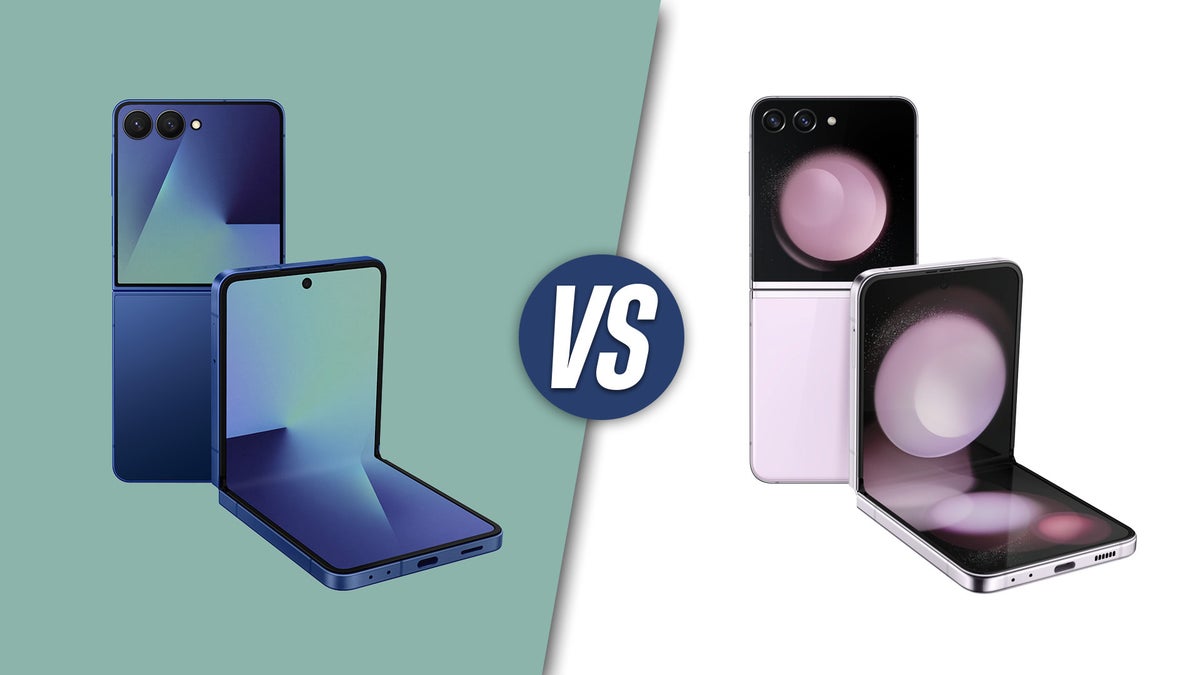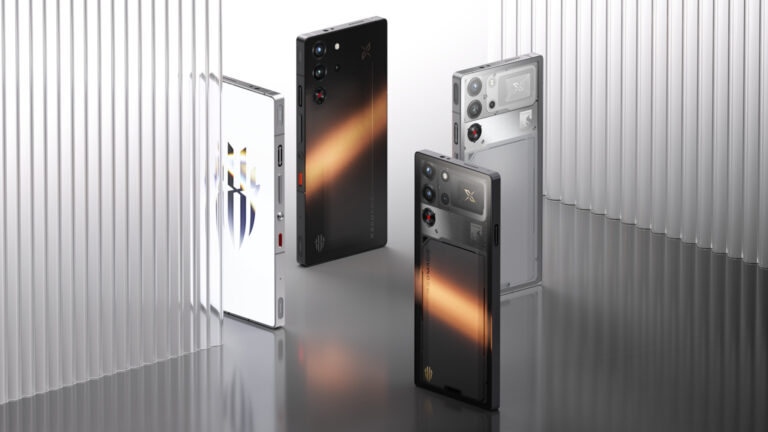Samsung Galaxy Z Flip 7 vs Galaxy Z Flip 5: Is it time to upgrade?
Intro
With the Motorola Razr Ultra already making rounds and getting a lot of attention, Samsung needed to bring some upgrades to the table in order to compete. And most importantly, convince its long-time fans to stay inside the ecosystem.
Galaxy Z Flip 7 vs Galaxy Z Flip 5 differences:
| Galaxy Z Flip 7 | Galaxy Z Flip 5 |
|---|---|
| Same overall design, slightly bigger footprint | A tad more compact device, potentially lighter |
| Same camera housing redesigned cover screen | Cover screen doesn’t wrap around the cameras |
| Upgraded 50MP main camera | One 12MP main camera and one 12MP ultrawide |
| 1-120Hz AMOLED main display, 2600 nits brightness | 120Hz AMOLED display, 1750 nits peak brightness |
| Slightly bigger display at 6.9 inches, lower pixel density | 6.7-inch display, 1080 x 2640 pixels resolution |
| Bigger 4.1-inch cover screen with 120Hz refresh rate | 3.4-inch cover screen, 60Hz refresh rate |
| Qualcomm Snapdragon 8 Elite platform/Exynos 2500 | Two generations older Snapdragon 8 Gen 2 chipset |
| 12GB of RAM | 8GB of RAM |
| Bigger 4,300 potentially better battery life | 3,700 mAh battery |
| The same charging speeds | 25W wired, 15W wireless charging |
Table of Contents:
Also read:
Design and Size
Slightly bigger dimensions
Тhe Galaxy Z Flip 7 follows in the same footsteps as its predecessors, including the Galaxy Z Flip 5. The listed dimensions suggest that the new model is a tad wider to accommodate the larger main screen. We’re talking a couple of millimeters, so nothing drastic.
The design is very similar between generations but the new phone features an edge-to-edge cover screen, similar to what Motorola has been doing for some time now. Overall, the Galaxy Z Flip 7 is also thinner, Samsung boasts 6.5 mm thickness unfolded and 13.7 mm folded, making it the thinnest Samsung flip phone to date.
The weight of the Galaxy Z Flip 7 is very similar to that of its predecessors, again Galaxy Z Flip 5 included. You can check the exact dimensions and weights in the table below.
| Galaxy Z Flip 7 | Galaxy Z Flip 5 |
|---|---|
| Thickness Unfolded: 6.5 mm Folded: 13.7 mm |
Thickness Unfolded: 6.9 mm Folded: 15.1 mm |
| Dimensions Unfolded: 166.7 x 75.2 Folded: 85.5 х 75.2 |
Dimensions Unfolded: 165.1 x 71.9 Folded: 85.1 x 71.9 |
| Weight 188 grams |
Weight 187 grams |
The Galaxy Z Flip 7 launched in four hues, one of which is a Samsung store exclusive. There’s a new Coral Red color, and the aforementioned exclusive color is Mint. You can see the color comparison with the Galaxy Z Flip 5 below.
| Galaxy Z Flip 7 | Galaxy Z Flip 5 |
|---|---|
| – | Cream |
| – | Graphite |
| – | Blue |
| Blue Shadow | Yellow |
| Mint (Samsung.com exclusive) | Mint |
| Jet Black | Lavender |
| Coral Red | Gray |
Display Differences
Bigger screens all around
Samsung has brought some changes to both displays of the Galaxy Z Flip 7, compared to last generation, and, of course, compared to the Galaxy Z Flip 5. The main flexible screen has grown in size to 6.9 inches, and the cover screen now stretches edge-to-edge coming in at 4.1 inches.
| Galaxy Z Flip 7* | Galaxy Z Flip 5 |
|---|---|
| Size Main screen: 6.9″ Cover screen: 4.1″ |
Size Main screen: 6.7″ Cover screen: 3.4″ |
| Brightness 2600 nits (peak) |
Brightness 1750 nits (peak) |
In our display test, the Galaxy Z Flip 5 managed only 857 nits of brightness at 100% APL, which, by 2025 standards, is average. We can’t wait to test the Galaxy Z Flip 7, but if we extrapolate from the previous generation, we should expect something in the ballpark of 1200 nits at 100% APL.
Both screens on the Galaxy Z Flip 7 are able to go up to 120 Hz, but the main one is an LTPO covering 1-120 Hz, while the cover has fixed 60/120 Hz refresh rates. The Galaxy Z Flip 5, on the other hand, can do only 60 Hz on its cover screen but features the same LTPO tech on the main display. Stay tuned for lab tests soon.
Performance and Software
Exynos makes a surprise return
Surprise, surprise! Exynos is back. The Galaxy Z Flip 7 comes with the Exynos 2500 chipset, the latest from Samsung foundries, built on a 3nm node. This is the debut of this specific silicon, so we don’t have any idea how it stacks against the Snapdragon 8 Elite.
We expected the Z Flip 7 to actually get the aforementioned Qualcomm chipset, but the surprise was real. We have to run some tests in our lab and see if Samsung has managed to close the gap to the benchmark-setting Snapdragon 8 Elite.
| Galaxy Z Flip 7 | Galaxy Z Flip 5 |
|---|---|
| Chip Samsung Exynos 2500 |
Chip Qualcomm Snapdragon 8 Gen 2 |
| Process 3nm |
Process 4nm |
| RAM 12GB |
RAM 8GB |
The RAM situation is in favor of the Galaxy Z Flip 7, the phone mimics the RAM of the previous model coming in at 12GB, which is still more than what the Galaxy Z Flip 5 has to offer, which is just 8GB of RAM.
The Galaxy Z Flip 7 launches with OneUI 8 out of the box over Android 16. In contrast, the Galaxy Z Flip 5, which is almost two years old now, was announced with OneUI 5 and Android 13 but was brought up to the latest OS with subsequent updates.
Speaking of updates, the Galaxy Z Flip 5 will get only four years of major OS updates (two are already in the drain), while the Galaxy Z Flip 7 will be supported for seven more years, which is a huge difference in longevity.
Camera
Main wide camera upgrades
| Galaxy Z Flip 7 | Galaxy Z Flip 5 |
|---|---|
| Main 50 MP f/1.8 23 mm (wide) 1/1.57″ |
Main 12 MP f/1.8 24 mm (wide) 1/1.76″ |
| Ultrawide 12 MP f/2.2 13 mm (ultrawide) 123 FOV |
Ultrawide 12 MP f/2.2 13 mm (ultrawide) 123 FOV |
As always, we have to keep in mind that hardware alone isn’t the deciding factor when we talk about smartphone photography, and different post-processing algorithms are in play. So, we’ll have to snap some side-by-side photos to see how the Galaxy Z Flip 7 fares against its older sibling in the camera department.
Battery Life and Charging
A substantial increase?
The Galaxy Z Flip 5 comes equipped with a 3700 mAh battery, which even at launch was a bit on the lower side. The phone managed only 5h 11m composite battery score in our test, which currently ranks it #117 in this department.
Now, the Galaxy Z Flip 7 brings a substantial upgrade (at least compared to the Z Flip 5). The battery capacity of the new flip flagship is 4300 mAh, exactly 600 mAh more than the Z Flip 5. This will inevitably lead to better battery life figures but we’ll have to test it to see the exact numbers.
| Galaxy Z Flip 7 | Galaxy Z Flip 5 |
|---|---|
| Battery capacity 4300 mAh |
Battery capacity 3700 mAh |
|
Charging speeds 15W wireless charging USB-C |
Charging speeds 25W wired 15W wireless charging USB-C |
Samsung seems so reluctant to upgrade the charging speeds of its phones. The Galaxy Z Flip 5 supports only 25W wired, and the Galaxy Z Flip 7 comes equipped with the same support, even after two long years between these generations.
Specs Comparison
| Galaxy Z Flip 7* | Galaxy Z Flip 5 |
|---|---|
| Size, weight 166.7 x 75.2 x 6.5 mm 188 g |
Size, weight 165.1 x 71.9 x 6.9 mm 187 g |
| Screen Main: 6.9″ AMOLED 1-120Hz 2600 nits peak Cover: 4.1″ 120Hz |
Screen Main: 6.7″ AMOLED 1-120Hz 1750 nits peak Cover: 3.4″ 60Hz |
| Processor Samsung Exynos 2500 3nm |
Processor Qualcomm Snapdragon 8 Gen 2 4nm |
| Versions: 12/256GB 12/512GB LPDDR5 |
Versions: 8/128GB 8/256GB 8/512GB LPDDR5 |
| Cameras: 50MP main 12MP ultrawide 10MP front |
Cameras: 12MP main 12MP ultrawide 10MP front |
| Battery: 4300 mAh |
Battery: 3,700 mAh |
| Charging: USB-C 25W wired 15W wireless charging |
Charging: USB-C 25W wired 15W wireless charging |
Summary
Next to the Galaxy Z Flip 5, the new model offers a better main camera, bigger inner and cover screens, a larger battery and potentially better battery life, new Exynos silicon, and the latest software with seven long years of support.
We will update this comparison with all the tests, benchmarks, camera samples, and display scores once we finish testing the Galaxy Z Flip 7, so stay tuned for the final verdict.






